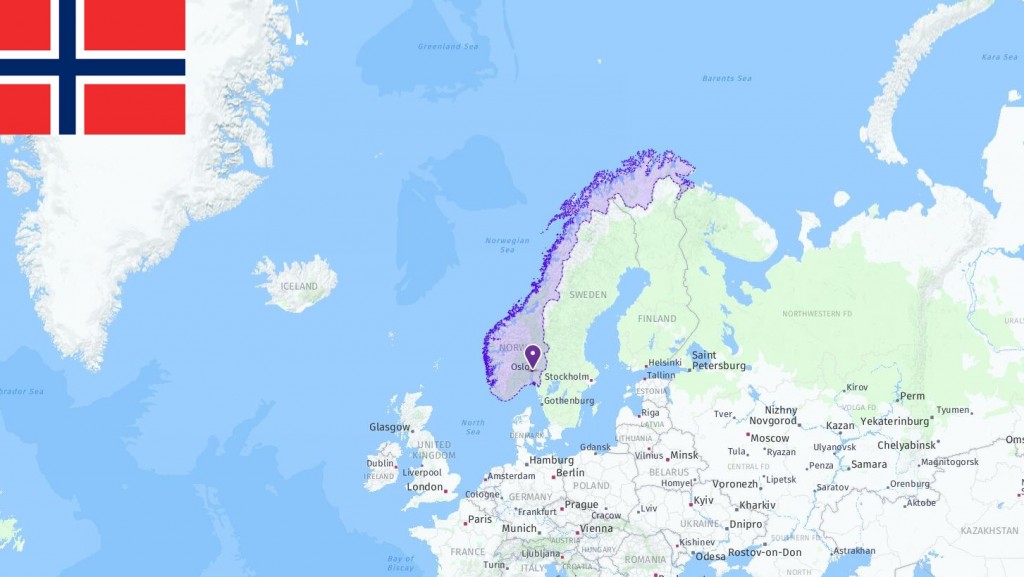NO is the abbreviation for Norway, the 67th largest country in the world. Officially the Kingdom of Norway, Norway is a country located in Europe, bordering 3 countries – Denmark, Finland, and Russia. Oslo is the capital city of Norway. Major cities include Oslo (population: 579,989), Bergen (population: 213,574), Trondheim (population: 147,128), Stavanger (population: 121,599), Drammen (population: 90,711), Fredrikstad (population: 72,749), Kristiansand (population: 63,803), Sandnes (population: 63,021), Asker (population: 60,915), and Tromsø (population: 52,425).
Country Profile
- Capital: Oslo
- Language: Norwegian
- Area: 385,207 km2
- Population: 5,328,201
- Currency: Norwegian krone (NOK)
- Time zone: UTC+1
- Calling code: 47
- ISO 2-Letter Abbreviation: NO
- UN 3-Letter Abbreviation: NOR
- Internet TLD: .no
- State Government Website: http://norway.no
List of Norway Acronyms
The most commonly used abbreviations about Norway are NO which stands for Norway and NOK which means Norwegian krone (Norway currency). In the following table, you can see all acronyms related to Norway, including abbreviations for airport, city, school, port, government, and etc.

Geography
Norway is an elongated country. It has a coastline of around 100 km, and is less than 6 km wide at its narrowest. The coast is characterized by deep fjords that formed during the last ice age. Inland there are several smaller mountain ranges and forest areas, with low lying plains in the middle of the country. The climate is warmer than the northern location would indicate, due to the warm Gulf Stream that runs along the coast. There are variations between the regions, with a dry, cold domestic climate in the country’s eastern parts, a wetter and more temperate coastal climate in the west, and Arctic, cold climate in the north.
Parts of the country were hit by the radioactive emissions following the Chernobyl accident in 1986, and some areas are still struggling with the aftermath. Norway is among the countries in the world that emit the most CO2 in terms of population.
History
For centuries, Norway was ruled by Viking chiefs and kings who ruled over smaller areas. In the 9th century, Harald Hårfagre gathered the country into one kingdom. Over the next 400 years, the Vikings conquered Iceland and Greenland, and went on raids over large parts of Europe. Norway was a major trading power at that time.
The country was severely hit by the Black Death in the mid-1300s, and nearly half of the population perished. From the end of the 1300s until 1814, Norway was in union with Denmark, and then in union with Sweden. The country first became independent in 1905.
Norway was initially neutral during both world wars, but was occupied by Germany during World War II. The post-war reconstruction of the country and the development of a strong welfare state. Norway voted no for membership in the EC in 1972, and the EU in 1994. After the country began extracting oil in the 1970s, the economy grew rapidly.
July 22, 2011, Norway was hit by a terrorist attack. A bomb in the government quarter in Oslo killed 8 people, and 77 people were shot at the Labor Party’s youth camp summer camp on Utøya. Right-wing extremist Anders Behring Breivik was convicted of the attacks.
Society and politics
Norway is a constitutional monarchy, where the king has symbolic duties and rights. The real power lies with the Storting, which is elected for four years at a time. The majority in the Storting forms government. Norway, like the other Scandinavian countries, has a strong social democratic tradition, but in recent decades parties on the right have gained greater and greater support.
Living standards in Norway are among the highest in the world, with very high living costs and a comprehensive tax and tax system. The country has a well-developed welfare system, with free education, a good health system and good social and social security schemes. How this system is to be financed when the oil comes to an end has emerged as one of the most important issues in Norwegian politics. Tax policy, increasing immigration and the role of the state in business are other key issues.
Norway is among the foremost in the world when it comes to gender equality and human rights. The Sami Parliament is located in Karasjok and was established in 1989. The thing is to secure the approximately 60,000 Sami living in the country political representation and participation.
Economics and Commerce
Before oil was discovered in the Norwegian Sea in the 1960s, Norway was a shipping, agricultural and fishing nation. The majority of the population worked within these industries.
Since the 1970s, Oil and natural gas extraction have been very important for the Norwegian economy. Economic developments have fluctuated in line with world oil prices. In the 1980s, Norway was hit by an economic crisis, with tightening and high unemployment. To counteract the effects of these fluctuations, in 1995 the state created a separate fund, where most of the profits from the oil industry were to be invested abroad. Oil revenues and developments in service sectors of the economy have made Norway one of the countries with the highest gross domestic product (GDP) per capita in the world.
Norway has good conditions for fishing and farming of fish and shellfish, and fish is one of the country’s most important export goods – by oil/gas. The state still has major ownership interests in the business sector, with recent years there has been a gradual privatization within industries such as telecommunications and transport. The Norwegian economy also felt the global financial crisis, but the consequences were less dramatic than in most other countries.
View this article in other languages:
Deutsch – Français – 繁體中文


